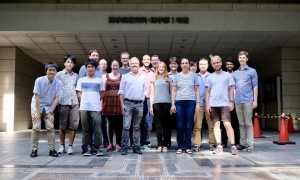Workshops don’t get much more intense than this. A group of students and experts from the CALICE Collaboration recently spent three weeks tucked away at the University of Tokyo to get their heads round and analyse all the data taken at the most recent testbeam of the CALICE calorimeter setup. What would normally take a couple of months was thus tackled in a couple of weeks, and the participants emerged with new ideas and lots of knowledge in their heads.
Funded through E-JADE, the EU-funded Europe-Japan Accelerator Development Exchange Programme which is part of the EU’s “Research and Innovation Staff Exchange” (RISE) programme, nine students from five universities and labs in Germany travelled to Japan. Three students from Japan completed the workshop, which was run by DESY scientists Katja Krüger and Felix Sefkow and Wataru Ootani from the University of Tokyo.
“We used the data we collected at the most recent testbeams with the 38-layer setup of the CALICE calorimeter”, explains Krüger. “With the help of the workshop participants we wanted to know more about the performance of the new setup, check the data quality and calibrate it accordingly.” And there was a lot of data – muons, electrons and pions in a rage from 10 to 200 GeV from CERN’s SPS accelerator, a total of more than 50 million events.
After a round of introductory talks in which all participants presented their area of specialisation the students picked individual topics and got cracking, convening every evening to present their achievements. All of them had prior knowledge of the calorimeter and its software and analysis tools, but mostly of one particular area. They emerged as one team, still efficiently sharing tasks, but with allround understanding of the CALICE world. What is more, they managed to thoroughly clean up and optimise the tools commonly used in this world.
For example, the software and all changes made to it were documented and the software itself was made more stringent and easier to improve. Codes like the one for particle identification were adapted to the latest test setup and all data calibrated extremely precisely with new calibrations constants.
Obviously all participants benefit directly from common tools to purify their data samples in terms of particle species, and from minimised ambiguities in the conversion of detector signals to physical energies.
“A lot remains to be done, but this workshop achieved an excellent common ground for the whole community and for tightening the collaboration between Japanese nd European scientits,” Felix Sefkow summarises. “We tried this format for the first time, but we’ll definitely do it again because it was so productive – and because the students accepted it enthusiastically.”


Recent Comments